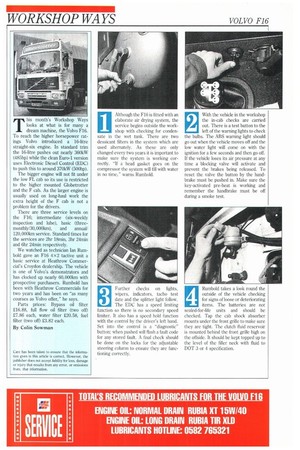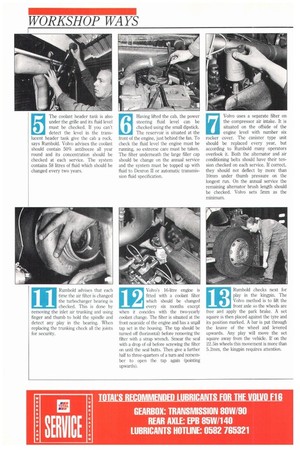T his month's Workshop Ways looks at what is for many
Page 83

Page 84

Page 89

If you've noticed an error in this article please click here to report it so we can fix it.
a dream machine, the Volvo F16. To reach the higher horsepower ratings Volvo introduced a 16-litre straight-six engine. In standard trim the 16-litre pushes out nearly 360kW (485hp) while the clean Euro-1 version uses Electronic Diesel Control (EDC) to push this to around 370kW (500hp).
The bigger engine will not fit under the low FL cab so its use is restricted to the higher mounted Globetrotter and the F cab. As the larger engine is usually used on long-haul work the extra height of the F cab is not a problem for the drivers.
There are three service levels on the F16; intermediate (six-weekly inspection and tube), basic (threemonthly/30,000km), and annual/ 120,000km service. Standard times for the services are 2hr 18min, 3hr 24min and 6hr 24min respectively.
We watched as technician Ian Rumbold gave an F16 4 x 2 tactive unit a basic service at Heathrow Commercial's Croydon dealership. The vehicle is one of Volvo's demonstrators and has clocked up nearly 60,0001un with prospective purchasers. Rumbold has been with Heathrow Commercials for two years and has been on "as many courses as Volvo offer," he says.
Parts prices: Bypass oil filter £16.88, full flow oil filter (two off) £7.86 each, water filter £20.58, fuel filter (two off) 23.82 each.
By Colin Sowman Although the F16 is fitted with an elaborate air drying system, the service begins outside the workshop with checking for condensate in the wet tank. There are two dessicant filters in the system which are used alternately. As these are only changed every two years it is important to make sure the system is working correctly. "If a head gasket goes on the compressor the system will fill with water in no time," warns Rumbold.
1
2 With the vehicle in the workshop
the in-cab checks are carried out. There is a test button to the left of the warning lights to check the bulbs. The ABS warning light should go out when the vehicle moves off and the low water light will come on with the ignition for a few seconds and then go off. If the vehicle loses its air pressure at any time a blocking valve will activate and prevent the brakes being released. To reset the valve the button by the handbrake must be pushed in. Make sure the key-activated pre-heat is working and remember the handbrake must be off during a smoke test.
3 Further checks on lights,
wipers, indicators, tacho test date and the splitter light follow.
The EI)C has a speed limiting function so there is no secondary speed limiter. It also has a speed hold function with the control by the driver's left hand. Set into the control is a "diagnostic" button; when pushed will flash a fault code for any stored fault. A final check should be done on the locks for the adjustable steering column to ensure they are functioning correctly. Rumbold takes a look round the outside of the vehicle checking for signs of loose or deteriorating items. The batteries are not sealed-for-life units and should be checked. Tap the cab shock absorber mounts under the front grille to make sure they are tight. The clutch fluid reservoir is mounted behind the front grille high on the offside. It should be kept topped up to the level of the filler neck with fluid to DOT 3 or 4 specification. The coolant header tank is also under the grille and its fluid level must be checked. If you can't detect the level in the translucent header tank give the cab a rock, says Rumbold. Volvo advises the coolant should contain 50% antifreeze all year round and its concentration should be checked at each service. The system contains 58 litres of fluid which should be changed every two years. Having lifted the cab, the power steering fluid level can be checked using the small dipstick. The reservoir is situated at the front of the engine, just behind the fan. To check the fluid level the engine must be running, so extreme care must be taken. The filter underneath the large filler cap should be change on the annual service and the system must be topped up with fluid to Dexron or automatic transmission fluid specification. Volvo uses a separate filter on the compressor air intake. It is situated on the offside of the engine level with number six rocker cover. The canister type unit should be replaced every year. but according to Rumbold many operators overlook it. Both the alternator and air conditioning belts should have their tension checked on each service. If correct, they should not deflect by more than lOmm under thumb pressure on the longest run. On the annual service the remaining alternator brush length should be checked. Volvo sets 5= as the minimum. With the change in its service procedures, Volvo says the fuel filters should only be changed on the annual service or if there is a complaint of loss of power. However, many operators wish to have them changed more frequently, especially if they feel they could be picking up dirty diesel in some Continental countries. For our benefit Rumbold changes the filters. He removes them with a strap wrench. The new ones should have their seals smeared with diesel before fitting. Screw them on until the seal butts and then give another half to three-quarters of a turn. The bleed screw for the fuel system is set on top of the filters' housing and the Lift pump is at the front of the injection pump. After loosening the bleed screw use the pump to expel the air. Do not over-tighten the bleed screw as it is drilled and will break. There is no need to screw the spring loaded priming pump plunger down. There is no sediment trap in the fuel system.
10 Air filter changes are now set at 18 month intervals
unless the vehicle is being used in very dusty conditions. There is a restriction indicator warning light in the cab to warn of severe blockages. The latest design of filter comes with the housing end cap incorporated. It can be fitted in four positions, allowing it to be turned. However, Volvo does not advise turning or blowing the filter out.




































































































